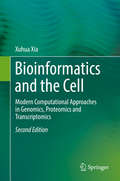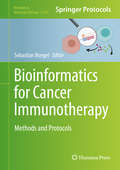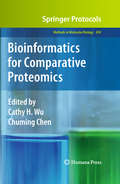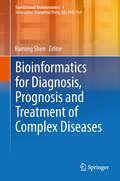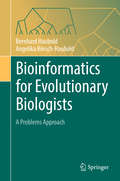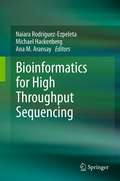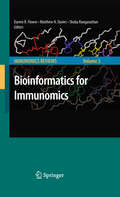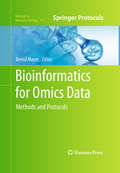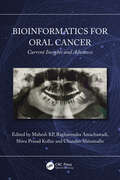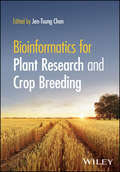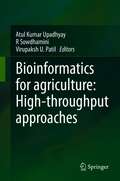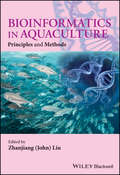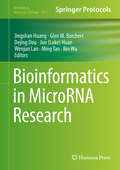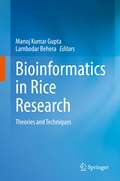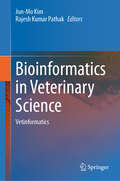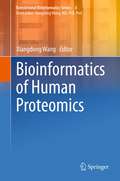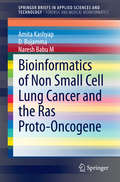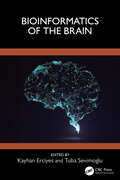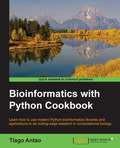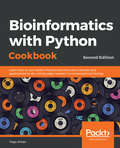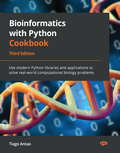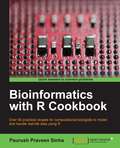- Table View
- List View
Bioinformatics and the Cell: Modern Computational Approaches in Genomics, Proteomics and Transcriptomics
by Xuhua XiaThis second edition integrates the more technical and mathematical aspects of bioinformatics with concrete examples of their application to current research problems in molecular, cellular and evolutionary biology. This broad, unified approach is made possible, in large part, by the very wide scope of Dr. Xia’s own research experience. The integration of genomics, proteomics and transcriptomics into a single volume makes this book required reading for anyone entering the new and emerging fields of Systems Biology and Evolutionary Bioinformatics.
Bioinformatics for Biologists
by Pavel Pevzner Ron ShamirThe computational education of biologists is changing to prepare students for facing the complex datasets of today's life science research. In this concise textbook, the authors' fresh pedagogical approaches lead biology students from first principles towards computational thinking. A team of renowned bioinformaticians take innovative routes to introduce computational ideas in the context of real biological problems. Intuitive explanations promote deep understanding, using little mathematical formalism. Self-contained chapters show how computational procedures are developed and applied to central topics in bioinformatics and genomics, such as the genetic basis of disease, genome evolution or the tree of life concept. Using bioinformatic resources requires a basic understanding of what bioinformatics is and what it can do. Rather than just presenting tools, the authors – each a leading scientist – engage the students' problem-solving skills, preparing them to meet the computational challenges of their life science careers.
Bioinformatics for Cancer Immunotherapy: Methods and Protocols (Methods in Molecular Biology #2120)
by Sebastian BoegelThis volume focuses on a variety of in silico protocols of the latest bioinformatics tools and computational pipelines developed for neo-antigen identification and immune cell analysis from high-throughput sequencing data for cancer immunotherapy. The chapters in this book cover topics that discuss the two emerging concepts in recognition of tumor cells using endogenous T cells: cancer vaccines against neo-antigens presented on HLA class I and II alleles, and checkpoint inhibitors. Written in the highly successful Methods in Molecular Biology series format, chapters include introductions to their respective topics, lists of the necessary materials and reagents, step-by-step, readily reproducible laboratory protocols, and tips on troubleshooting and avoiding known pitfalls.Cutting-edge and authoritative, Bioinformatics for Cancer Immunotherapy: Methods and Protocols is a valuable research tool for any scientist and researcher interested in learning more about this exciting and developing field.
Bioinformatics for Comparative Proteomics (Methods in Molecular Biology #694)
by Cathy H. Wu Chuming ChenWith the rapid development of proteomic technologies in the life sciences and in clinical applications, many bioinformatics methodologies, databases, and software tools have been developed to support comparative proteomics study. In Bioinformatics for Comparative Proteomics, experts in the field highlight the current status, challenges, open problems, and future trends for developing bioinformatics tools and resources for comparative proteomics research in order to deliver a definitive reference providing both the breadth and depth needed on the subject. Structured in three major sections, this detailed volume covers basic bioinformatics frameworks relating to comparative proteomics, bioinformatics databases and tools for proteomics data analysis, and integrated bioinformatics systems and approaches for studying comparative proteomics in the systems biology context. Written for the highly successful Methods in Molecular BiologyTM series, the contributions in this book provide the meticulous, step-by-step description and implementation advice that is crucial for getting optimal results in the lab. Comprehensive and easy-to-use, Bioinformatics for Comparative Proteomics serves all readers who wish to learn about state-of-the-art bioinformatics databases and tools, novel computational methods and future trends in proteomics data analysis, and comparative proteomics in systems biology.
Bioinformatics for DNA Sequence Analysis (Methods in Molecular Biology #537)
by David PosadaThe storage, processing, description, transmission, connection, and analysis of the waves of new genomic data have made bioinformatics skills essential for scientists working with DNA sequences. In Bioinformatics for DNA Sequence Analysis, experts in the field provide practical guidance and troubleshooting advice for the computational analysis of DNA sequences, covering a range of issues and methods that unveil the multitude of applications and the vital relevance that the use of bioinformatics has today. Individual book chapters explore the use of specific bioinformatic tools, accompanied by practical examples, a discussion on the interpretation of results, and specific comments on strengths and limitations of the methods and tools. As a part of the highly successful Methods in Molecular BiologyTM series, this work provides the kind of detailed description and implementation advice that is crucial for getting optimal results. Focused and cutting-edge, Bioinformatics for DNA Sequence Analysis serves molecular biologists, geneticists, and biochemists as an enriched task-oriented manual, offering step-by-step guidance for the analysis of DNA sequences in a simple but meaningful fashion.
Bioinformatics for Diagnosis, Prognosis and Treatment of Complex Diseases (Translational Bioinformatics #4)
by Bairong ShenThe book introduces the bioinformatics tools, databases and strategies for the translational research, focuses on the biomarker discovery based on integrative data analysis and systems biological network reconstruction. With the coming of personal genomics era, the biomedical data will be accumulated fast and then it will become reality for the personalized and accurate diagnosis, prognosis and treatment of complex diseases. The book covers both state of the art of bioinformatics methodologies and the examples for the identification of simple or network biomarkers. In addition, bioinformatics software tools and scripts are provided to the practical application in the study of complex diseases. The present state, the future challenges and perspectives were discussed. The book is written for biologists, biomedical informatics scientists and clinicians, etc. Dr. Bairong Shen is Professor and Director of Center for Systems Biology, Soochow University; he is also Director of Taicang Center for Translational Bioinformatics.
Bioinformatics for Evolutionary Biologists: A Problems Approach
by Bernhard Haubold Angelika Börsch-HauboldThis self-contained textbook covers fundamental aspects of sequence analysis in evolutionary biology, including sequence alignment, phylogeny reconstruction, and coalescent simulation. It addresses these aspects through a series of over 400 computer problems, ranging from elementary to research level to enable learning by doing. Students solve the problems in the same computational environment used for decades in science - the UNIX command line. This is available on all three major operating systems for PCs: Microsoft Windows, Mac-OSX, and Linux. To learn using this powerful system, students analyze sample sequence data by applying generic tools, bioinformatics software, and over 40 programs specifically written for this course. The solutions for all problems are included, making the book ideal for self-study. Problems are grouped into sections headed by an introduction and a list of new concepts and programs. By using practical computing to explore evolutionary concepts and sequence data, the book enables readers to tackle their own computational problems.
Bioinformatics for High Throughput Sequencing
by Ana M. Aransay Naiara Rodríguez-Ezpeleta Michael HackenbergNext generation sequencing is revolutionizing molecular biology. Owing to this new technology it is now possible to carry out a panoply of experiments at an unprecedented low cost and high speed. These go from sequencing whole genomes, transcriptomes and small non-coding RNAs to description of methylated regions, identification protein - DNA interaction sites and detection of structural variation. The generation of gigabases of sequence information for each of this huge bandwidth of applications in just a few days makes the development of bioinformatics applications for next generation sequencing data analysis as urgent as challenging.
Bioinformatics for Immunomics (Immunomics Reviews: #3)
by Shoba Ranganathan Matthew Davies Darren D.R. FlowerThe field of Immunomics has developed within the post-genomic era as a response to the massive amount of biological and immunological data now available to researchers. Immunomics crosses the disciplines of immunology, genomics, proteomics and computational biology and address some fundamental problems in biological and medical research. This book covers some of the rich sources of immunological data that are currently available and describes the various bioinformatics techniques that have been utilized to aid our understanding of the immune system. It also describes the nature of the self/non-self distinction that forms the basis of immunological theory and how computational modeling can help to clarify our understanding of how the immune system works. This is the fourth volume in a series that will be dedicated to publishing advances in immunomics particularly those focusing on systemic and integrative approaches in basic and clinical immunology, immunoinformatics, and immunologically relevant instrumentation and high-throughput screening methods.
Bioinformatics for Omics Data: Methods and Protocols (Methods in Molecular Biology #719)
by Bernd MayerPresenting an area of research that intersects with and integrates diverse disciplines, including molecular biology, applied informatics, and statistics, among others, Bioinformatics for Omics Data: Methods and Protocols collects contributions from expert researchers in order to provide practical guidelines to this complex study. Divided into three convenient sections, this detailed volume covers central analysis strategies, standardization and data-management guidelines, and fundamental statistics for analyzing Omics profiles, followed by a section on bioinformatics approaches for specific Omics tracks, spanning genome, transcriptome, proteome, and metabolome levels, as well as an assortment of examples of integrated Omics bioinformatics applications, complemented by case studies on biomarker and target identification in the context of human disease. Written in the highly successful Methods in Molecular BiologyTM series format, chapters contain introductions to their respective topics, lists of the necessary materials and reagents, step-by-step, readily reproducible laboratory protocols, and notes on troubleshooting and avoiding known pitfalls. Authoritative and accessible, Bioinformatics for Omics Data: Methods and Protocols serves as an ideal guide to scientists of all backgrounds and aims to convey the appropriate sense of fascination associated with this research field.
Bioinformatics for Oral Cancer: Current Insights and Advances
by Raghavendra Amachawadi Shiva Prasad Kollur Chandan Shivamallu Mahesh KpAmid the rising global concern of oral cancer, this book provides a compelling exploration of the intricate oral cavity, focused on shedding light on early diagnosis and addressing outdated paradigms, it delves into the persistent challenges of oral premalignant lesions. Tailored for both beginners and researchers, its six chapters encompass the spectrum of genome sequencing, diagnostic biomarkers, gene expression, and more. Discover a fusion of basic and clinical sciences, aiming to invigorate the study of bioinformatics and oral cancer, and ultimately improve survival rates.Bioinformatics for Oral Cancer: Current Insights and Advances serves as a comprehensive guide, offering a deep dive into the multifaceted landscape of oral cancer research and bioinformatics. Within its pages, readers will uncover a wealth of knowledge, starting with foundational chapters introducing bioinformatics and establishing the backdrop of oral cancer. The book then progresses into the realm of diagnostic biomarkers, revealing cutting-edge methodologies for their identification in the context of oral cancer. The book’s keen focus extends to gene expression profiles and the intricacies of gene sequencing in the context of oral cancer progression. By systematically unravelling these critical aspects, the book bridges the gap between basic and clinical sciences, equipping readers with a holistic understanding of bioinformatics’ pivotal role in enhancing our grasp of oral cancer’s complexities.By deciphering the enigmatic landscape of oral premalignant lesions, the book equips clinicians and researchers with tools to predict malignant potentials. Its meticulous exploration of gene expression profiles and sequencing promises to reshape early detection strategies, propelling the field towards improved diagnosis and treatment outcomes.
Bioinformatics for Plant Research and Crop Breeding
by Jen-Tsung ChenExplore and advance bioinformatics and systems biology tools for crop breeding programs in this practical resource for researchers Plant biology and crop breeding have produced an immense amount of data in recent years, from genomics to interactome and beyond. Bioinformatics tools, which aim at analyzing the vast quantities of data produced by biological research and processes, have developed at a rapid pace to meet the challenges of this vast data trove. The resulting field of bioinformatics and systems biology is producing increasingly rich and transformative research. Bioinformatics for Plant Research and Crop Breeding offers an overview of this field, its recent advances, and its wider applications. Drawing on a range of analytical and data-science tools, its foundation on an in-silico platform acquired multi-omics makes it indispensable for scientists and researchers alike. It promises to become ever more relevant as new techniques for generating and organizing data continue to transform the field. Bioinformatics for Plant Research and Crop Breeding readers will also find: A focus on emerging trends in plant science, sustainable agriculture, and global food security Detailed discussion of topics including plant diversity, plant stresses, nanotechnology in agriculture, and many othersApplications incorporating artificial intelligence, machine learning, deep learning and more Bioinformatics for Plant Research and Crop Breeding is ideal for researchers and scientists interested in the potential of OMICs, and bioinformatic tools to aid and develop crop improvement programs.
Bioinformatics for Systems Biology
by Stephen KrawetzThe biological sciences are now in the midst of a true life sciences revolution akin to what physics experienced just after the turn of the last century. We are now in a phase of unparalleled growth that is reflected by the amount of data generated from each experiment. At the time of this writing, the rate of data acquisition was approaching 2 terabytes over the course of 5 days with first pass analysis proceeding over the following 2-3 week period. This fundamental shift has provided unprecedented opportunities that for the first time afford us the ability, i.e., means, breadth, and depth of data, to truly address human biology at the systems level. This wealth of information from seemingly disparate datasets and its integration is being realized through bioinformatics. It is with this philosophy that the text Bioinformatics for Systems Biology was born. This revolution has spawned true personalized medicine that encompasses diagnostics and treatment through to cure. For the physical and computer scientist, this text provides an introduction to the basic biological principles governing a cell. This quickly moves from the fundamentals to exploring the underlying genetic processes. While providing a rudimentary and necessary overview for the life scientist, the physical and computer scientist will be apprised of various nuances within the field reflecting the reality of "wet-bench" science. For those in the life sciences, it is rapidly becoming appreciated that we are progressing from examining our favorite "pet" gene to the system. Statistics is now an essential component to understand the vast datasets and this is emphasized throughout the text. The majority of the text is devoted to the common ground that these groups share. It provides rich examples of tools, databases, and strategies to mine the databases to reveal novel insights. A host of examples of parsing the data into a series of overlays that use various presentation systems are reviewed. The goal is to provide a representation most comfortable to the user to enable the user to thoroughly explore the data. The text concludes with examples of how the systems information is used to inform personalized medicine in a true "bench to bedside" manner. Bioinformatics for Systems Biology bridges and unifies many disciplines. It presents the life scientist, computational biologist, and mathematician with a common framework. Only by linking the groups together may the true life sciences revolution move forward in the mostly uncharted and emerging field of Systems Biology.
Bioinformatics for agriculture: High-throughput approaches
by Atul Kumar Upadhyay R Sowdhamini Virupaksh U. PatilThis book illustrates the importance and significance of bioinformatics in the field of agriculture. It first introduces the basic concepts of bioinformatics, such as homologous sequence and gene function analyses, determination of protein structures, and discusses machine learning applications for an in-depth understanding of the desired genes and proteins based on commonly used bioinformatics software and tools, e.g. BLAST, molecular modelling, molecular-docking and simulations, protein-protein and domain-domain interactions. The book also describes recent advances in the high-throughput analysis of whole genome and transcriptome using next-generation sequencing platforms, and functional proteome studies. It also examines the role of computational biology in understanding and improving the nutrient quality and yield of crops. Lastly, the book explores a comprehensive list of applications of bioinformatics to improve plant yield, biomass, and health, and the challenges involved.
Bioinformatics in Aquaculture: Principles and Methods
by Zhanjiang John LiuBioinformatics derives knowledge from computer analysis of biological data. In particular, genomic and transcriptomic datasets are processed, analysed and, whenever possible, associated with experimental results from various sources, to draw structural, organizational, and functional information relevant to biology. Research in bioinformatics includes method development for storage, retrieval, and analysis of the data. Bioinformatics in Aquaculture provides the most up to date reviews of next generation sequencing technologies, their applications in aquaculture, and principles and methodologies for the analysis of genomic and transcriptomic large datasets using bioinformatic methods, algorithm, and databases. The book is unique in providing guidance for the best software packages suitable for various analysis, providing detailed examples of using bioinformatic software and command lines in the context of real world experiments. This book is a vital tool for all those working in genomics, molecular biology, biochemistry and genetics related to aquaculture, and computational and biological sciences.
Bioinformatics in MicroRNA Research (Methods in Molecular Biology #1617)
by Bin Wu Jingshan Huang Glen M. Borchert Dejing Dou Jun Luke Huan Wenjun Lan Ming TanThis thorough volume provides an in-depth introduction to and discussion of microRNAs (miRs) and their targets, miR functions, and computational techniques applied in miR research, thus serving the need for a comprehensive book focusing on miR target genes, miR regulation mechanisms, miR functions performed in various human diseases, and miR databases/knowledgebases. Without prior knowledge of the area of study, computational biologists, computer scientists, bioinformaticians, bench biologists, as well as clinical investigators will find it easy to follow the techniques in this collection. Written for the highly successful Methods in Molecular Biology series, chapters include the kind of detailed implementation advice that ensures successful results. Accessible and practical, Bioinformatics in MicroRNA Research functions as an ideal guide for researchers of all backgrounds to explore this vital area of study.
Bioinformatics in Rice Research: Theories and Techniques
by Manoj Kumar Gupta Lambodar BeheraThis book provides an up-to-date review of classic and advanced bioinformatics approaches and their utility in rice research. It summarizes databases and tools for analyzing DNA, proteins and gene expression profiles, mapping genetic variations, annotation of protein and RNA molecules, phylogenetic analysis, and pathway enrichment.In addition, it presents high-throughput technologies that are widely used to provide deep insights into the genetic architecture of important traits in the rice genome. The book subsequently discusses techniques for identifying RNA-protein, DNA-protein interactions, and molecular markers, including SNP and microsatellites, in the contexts of rice breeding and genetics.Lastly, it explores various tools that are used to identify and characterize non-coding RNA in rice and their potential role in rice research.
Bioinformatics in Veterinary Science: Vetinformatics
by Jun-Mo Kim Rajesh Kumar PathakThis book presents a compendium of advanced research and basic principles/approaches related to vetinformatics. All chapters have explored the role of basic methods of vetinformatics that may be very helpful for students and researchers studying/working in the area of veterinary and animal science and may also serve the purpose of textbook. The latest developments in the field are discussed, and basic concepts are introduced in a simple but comprehensive way to ensure that students/researchers are able to understand the more advanced study in the proposed field. It also provides a comprehensive list of resources used for RNAseq data analysis, metagenomics, GWAS, systems biology and multiomics integration, molecular docking, toxicity prediction, QSAR, molecular dynamics simulation, vaccine designing, and machine learning. This book serves as an invaluable resource for researchers, faculty, and students of veterinary and animal sciences for understanding modern approaches and the application of vetinformatics involved in livestock research. This also focuses to guide map and carry out studies and research in the field of vetinformatics.
Bioinformatics of Human Proteomics (Translational Bioinformatics #3)
by Xiangdong Wang"Bioinformatics of Human Proteomics" discusses the development of methods, techniques and applications in the field of protein bioinformatics, an important direction in bioinformatics. It collects contributions from expert researchers in order to provide a practical guide to this complex field of study. The book covers the protein interaction network, drug discovery and development, the relationship between translational medicine and bioinformatics, and advances in proteomic methods, while also demonstrating important bioinformatics tools and methods available today for protein analysis, interpretation and predication. It is intended for experts or senior researchers in the fields of clinical research-related biostatistics, bioinformatics, computational biology, medicine, statistics, system biology, molecular diagnostics, biomarkers, or drug discovery and development. Dr.Xiangdong Wang works as a distinguished professor of Respiratory Medicine at Fudan University, Shanghai, China. He serves as Director of Biomedical Research Center, Fudan University Zhongshan Hospital and adjunct professor of Clinical Bioinformatics at Lund University, Sweden. His main research is focused on the role of clinical bioinformatics in the development of disease-specific biomarkers and dynamic network biomarkers, the molecular mechanism of organ dysfunction and potential therapies.
Bioinformatics of Non Small Cell Lung Cancer and the Ras Proto-Oncogene (SpringerBriefs in Applied Sciences and Technology)
by Amita Kashyap D. Bujamma Naresh Babu MCancer is initiated by activation of oncogenes or inactivation of tumor suppressor genes. Mutations in the K-ras proto-oncogene are responsible for 10-30% of adenocarcinomas. Clinical Findings point to a wide variety of other cancers contributing to lung cancer incidence. Such a scenario makes identification of lung cancer difficult and thus identifying its mechanisms can contribute to the society. Identifying unique conserved patterns common to contributing proto-oncogenes may further be a boon to Pharmacogenomics and pharmacoinformatics. This calls for ab initio/de novo drug discovery that in turn will require a comprehensive in silico approach of Sequence, Domain, Phylogenetic and Structural analysis of the receptors, ligand screening and optimization and detailed Docking studies. This brief involves extensive role of the RAS subfamily that includes a set of proteins, which cause an over expression of cancer-causing genes like M-ras and initiate tumour formation in lungs. SNP Studies and Structure based drug discovery will also be undertaken.
Bioinformatics of the Brain
by Kayhan Erciyes Tuba SevimogluThe brain consisting of billions of neurons is probably the most complex and mysterious organ of the body. Understanding the functioning of the brain in its health and disease states has baffled the researchers working in this area for many years. The diversity of brain diseases and disorders makes the analysis of brain functions an even more challenging area of research. In vitro and in vivo studies regarding the brain may be laborious, however, bioinformatics using in silico approaches may take the burden off the experimental studies and give us a clearer perspective on disease and healthy states of the brain, its functions, and disease mechanisms.Recent advancements in neuroimaging technologies, the development of high-performance computers and the development of software, algorithms and methods to analyze data obtained from various neuroimaging processes have opened new frontiers in neuroscience enabling unprecedented finer analysis of the brain functions. This relatively new approach of brain analysis which may be termed Bioinformatics of the Brain is the main subject of this volume aiming to provide a thorough review of various bioinformatics approaches for analyzing the functioning of the brain and understanding brain diseases such as neurodegenerative diseases, brain tumors, and neuropsychiatric disorders. Authors from various disciplines in this volume each focus on a different aspect aiming to expand our understanding of this area of research. Topics included are: Brain diseases and disorders Stem cell therapy of neurodegenerative diseases Tissue engineering applications of gliomas Brain tumor detection and modeling Brain tumor growth simulation Brain-computer interface Bioinformatics of brain diseases Graph-theoretical analysis of complex brain networks Brain proteomics This book is intended to aid scientists, researchers, and graduate students in carrying out interdisciplinary research in the areas of bioinformatics, bioengineering, computer engineering, software engineering, mathematics, molecular biology, genetics, and biotechnology.
Bioinformatics with Python Cookbook
by Tiago AntaoIf you have intermediate-level knowledge of Python and are well aware of the main research and vocabulary in your bioinformatics topic of interest, this book will help you develop your knowledge further.
Bioinformatics with Python Cookbook - Second Edition
by Tiago AntaoThis book is for Data Scientists, Bioinformatics analysts, researchers, and Python developers who want to address intermediate-to-advanced common biological and bioinformatics problems with the recipe-based approach. Working knowledge of Python programming language is expected.
Bioinformatics with Python Cookbook: Use modern Python libraries and applications to solve real-world computational biology problems, 3rd Edition
by Tiago AntaoDiscover modern, next-generation sequencing libraries from the powerful Python ecosystem to perform cutting-edge research and analyze large amounts of biological dataKey FeaturesPerform complex bioinformatics analysis using the most essential Python libraries and applicationsImplement next-generation sequencing, metagenomics, automating analysis, population genetics, and much moreExplore various statistical and machine learning techniques for bioinformatics data analysisBook DescriptionBioinformatics is an active research field that uses a range of simple-to-advanced computations to extract valuable information from biological data, and this book will show you how to manage these tasks using Python.This updated third edition of the Bioinformatics with Python Cookbook begins with a quick overview of the various tools and libraries in the Python ecosystem that will help you convert, analyze, and visualize biological datasets. Next, you'll cover key techniques for next-generation sequencing, single-cell analysis, genomics, metagenomics, population genetics, phylogenetics, and proteomics with the help of real-world examples. You'll learn how to work with important pipeline systems, such as Galaxy servers and Snakemake, and understand the various modules in Python for functional and asynchronous programming. This book will also help you explore topics such as SNP discovery using statistical approaches under high-performance computing frameworks, including Dask and Spark. In addition to this, you'll explore the application of machine learning algorithms in bioinformatics.By the end of this bioinformatics Python book, you'll be equipped with the knowledge you need to implement the latest programming techniques and frameworks, empowering you to deal with bioinformatics data on every scale.What you will learnBecome well-versed with data processing libraries such as NumPy, pandas, arrow, and zarr in the context of bioinformatic analysisInteract with genomic databasesSolve real-world problems in the fields of population genetics, phylogenetics, and proteomicsBuild bioinformatics pipelines using a Galaxy server and SnakemakeWork with functools and itertools for functional programmingPerform parallel processing with Dask on biological dataExplore principal component analysis (PCA) techniques with scikit-learnWho this book is forThis book is for bioinformatics analysts, data scientists, computational biologists, researchers, and Python developers who want to address intermediate-to-advanced biological and bioinformatics problems. Working knowledge of the Python programming language is expected. Basic knowledge of biology will also be helpful.
Bioinformatics with R Cookbook
by Paurush Praveen SinhaThis book is an easy-to-follow, stepwise guide to handle real life Bioinformatics problems. Each recipe comes with a detailed explanation to the solution steps. A systematic approach, coupled with lots of illustrations, tips, and tricks will help you as a reader grasp even the trickiest of concepts without difficulty.This book is ideal for computational biologists and bioinformaticians with basic knowledge of R programming, bioinformatics and statistics. If you want to understand various critical concepts needed to develop your computational models in Bioinformatics, then this book is for you. Basic knowledge of R is expected.
